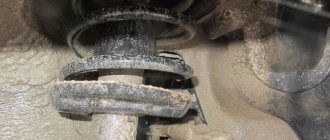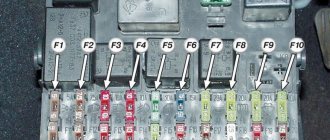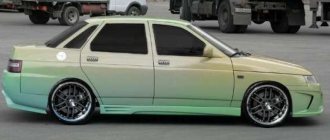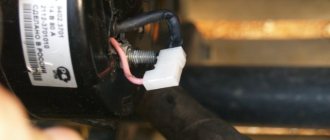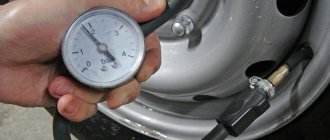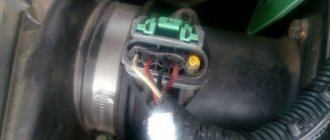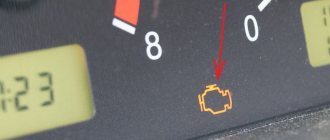Backlash is a term in mechanics that implies the presence of free movement in an element of a mechanical system. It represents a parameter by which one can judge the amount of movement of the node mentioned above to obtain a response from another - the controlled node.
In other words, the amount of backlash is characterized as the amount of rotation or displacement of the controlled element, which does not lead to any changes in the object.
In relation to a car and steering, the angle of rotation of the steering wheel at which the car continues to move in the same direction.
What is meant by total steering wheel play?
Another term that requires consideration is “total backlash.” It refers to the total angle, which starts from the extreme position of the steering wheel on one side when turning begins, to the opposite position when the car starts moving in the other direction.
To understand the principles of operation of the total backlash, it is important to understand the design and operating features of the control system. Based on the technical component, the operating principle of the backlash is as follows.
There is a rod in the transmission of steering rods, which is fixed with a small gap of one or two millimeters.
This distance is necessary to protect the steering system linkages from wear due to excessive friction.
The presence of a gap is a technological solution that allows you to keep the hook in the required position and not touch the surface of the teeth.
For the driver, this parameter represents free movement of the steering wheel, which allows for more precise control of the car and to feel at what moment the direction of movement of the vehicle changes.
Essentially, this is the total distance the steering wheel travels before the car moves to the left or right.
Many people mistakenly consider this phenomenon negative and try to get rid of it. You shouldn’t do this, because play in the steering is the norm for every car. Another thing is that it must have a strictly defined value.
An interesting pattern can be traced here - the larger the car’s dimensions, the higher the backlash indicator.
In the process of measuring the total backlash, a number of conditions must be met:
- The front wheels are located in a neutral position and stand on a hard (asphalt or concrete) surface.
- The steering wheel tires are dry and clean.
- The car engine is started. This is relevant if the operation of the power steering is tested.
- The tension of the power steering pump drive belt, as well as the level of the working fluid, must meet the requirements approved by the manufacturer.
The total play is checked by measuring the angle of rotation of the control wheel between the fixed positions for changing movement to the left and right.
To obtain accurate parameters, measurements are made two or more times.
Description of car steering play
The first mechanism in a car where you can expect abnormal free play to appear is the steering column. Structurally, it consists of a rod fixed on a shaft containing hinges.
All these components are connected through a gear drive. Even when fresh from the factory, it has some clearance. This design solution is necessary to prevent excessive wear of the tooth edges due to friction.
To make sure there is play, you need to rotate the steering wheel in different directions so as not to change the direction of the wheels. Operating a car inevitably causes an increase in free play in moving joints. The reason for this is simply simple - natural depreciation of parts.
Since, for natural reasons, gear and articulated drives wear out gradually, it is quite problematic to notice an increase in the steering play of the car. To control the process, you need to check the free play from time to time. In the case of a passenger car, steering wheel play within three centimeters is considered acceptable.
There are situations when the response to turning the steering wheel becomes more sluggish while driving. Then you need to stop driving as quickly as possible and find out the reason for this behavior of the car.
Knocking, creaking and vibration, as well as arbitrary changes in the given trajectory of movement are also signs of a steering failure. All of them are dangerous because a driver with a faulty steering mechanism may lose control and cause an accident.
Permissible backlash in cars
The traffic regulations stipulate normalized indicators of total play for various cars. In addition, this parameter should not exceed the figures specified in the documentation for the operation of the machine.
If there are no special recommendations in the manufacturer’s papers, the backlash should be as follows:
- For passenger cars, as well as bus and truck components made on their basis - 100;
- For buses - 200;
- For trucks - 250.
There are also separate recommendations for some models:
- For VAZ-2106, 2107, 2110, 21213 - 50;
- For Gazelle 3302 - 200 (passenger version) and 250 (truck).
What is steering play, its causes and elimination
- What is steering play, its causes and elimination
- What is steering play
- Permissible steering wheel play
- What tool is used to check
- How to check
- Possible causes of play and their diagnosis
- Engine off
- When driving
- When braking
- How to eliminate backlash
- In the steering column
- Video: Eliminating steering play
- Steering wheel
A car is not only a means of transportation, but also a mechanism that can endanger human life. Frequent use wears out car parts and causes them to malfunction. From this article you will learn about steering play and how to remove it, the causes of it and how to measure it. It will also become clear what value of play can be allowed.
- What is steering play
- Permissible steering wheel play
- What tool is used to check How to check
- Engine off
- In the steering column Video: Eliminating play in the steering wheel
Reasons for large backlash
The increase in play can be explained by changes in the design features of the steering, as well as the destruction of their elements.
The main reasons include:
- Worn gear bar and steering rack gear teeth.
- Damage or deformation of the wheel bearing. There are cases when it falls apart during operation, which leads to an increase in backlash (but there will be no time for backlash).
- Malfunction of tips and tie rods, which often break if operating requirements are not followed. The result is the same as in the previous case - “looseness” of the steering wheel.
- Poor quality repair of the vehicle chassis. There are situations when steering play manifests itself after visiting a service station. This is possible when service technicians do not tighten the wheel bearing nut sufficiently. As a result, the car's steering system suffers.
- Breakage of the ball joint (lower or upper), as well as pulling the steering rack with excessive force.
- Outdated hydraulic oil that requires replacement. Often play in the steering is eliminated after filling with new working fluid.
Generally speaking, play occurs when there is a fault in the chain between the steering wheel and the wheels.
To find out the reason, you need to go through the entire chain and identify the “weak” points. The main thing is to make sure that we are talking about increased free play, and not about other problems.
Other causes of play in the steering include:
- Wear or incorrect adjustment of the engagement of the “worm” and the roller mechanism.
- Worn swing arm axle or bushings.
- Loose crankcase fasteners.
How to determine the appearance of play in the steering
In order to check the car for problems with the steering, namely the presence of play, the following operations must be performed. First of all, it is necessary to switch the engine to a special operating mode when the vehicle is stationary - idle. After this, you should start turning the steering wheel and monitor the response time of the wheels to these commands. It is this distance that shows the amount of play.
Today, for the convenience and accuracy of measuring backlash, there is a special device - a backlash meter. It helps to measure and control the total backlash.
Signs of breakdown
As noted above, in order to effectively eliminate a malfunction, it must be diagnosed in a timely manner. To do this, it is enough to know the signs of play in the steering.
The main symptoms include:
- The appearance of a knock in the steering mechanism;
- Increased vibrations while driving;
- Creaking when turning wheels;
- Deviation from a given trajectory when the steering wheel is in a straight position.
When adjusting the steering play, you should take into account the manufacturer’s recommendations and traffic rules.
The configured parameter should not exceed the upper limit, but you should not underestimate the indicator either.
Too little steering wheel play can lead to additional discomfort and poor vehicle controllability.
At the same time, you should not ignore the appearance of a small backlash, because over time this parameter may increase, and then it will be more difficult to deal with the problem.
And it’s inconvenient to drive a car when you constantly have to “catch the road” and turn the steering wheel in one direction or the other.
Also read about the causes of knocking when turning the steering wheel.
Steering VAZ 2107
The steering mechanism of the VAZ “Seven” consists of several units connected together by means of fasteners. These components and their constituent elements, like any other part of the car, wear out over time and become unusable. The purpose, design, repair and maintenance of the VAZ 2107 steering system should be discussed in more detail.
Purpose
The main function assigned to the steering mechanism is to ensure the vehicle moves in the direction specified by the driver. On most passenger cars, the trajectory of movement is carried out by turning the wheels of the front axle. The steering mechanism of the “seven” is quite complex, but at the same time it provides trouble-free control in different situations on the road. The car is equipped with a safety steering column with a driveshaft that folds upon impact. The steering wheel of the mechanism in question has a diameter of 40 cm and to completely turn the wheels you need to make only 3.5 turns, which allows you to perform maneuvers without much difficulty.
What does it consist of?
The front wheel control mechanism on the VAZ 2107 is made of the following basic elements:
- steering wheel;
- shaft;
- gearbox;
- bipod;
- trapezoid;
- pendulum;
- steering knuckles.
Steering shaft
Through the shaft, rotation from the steering wheel is transmitted to the steering column. The shaft is secured with a bracket to the car body. Structurally, the element is made in the form of a cardan with crosspieces and an upper shaft. In the event of a collision, the mechanism folds, thereby ensuring the safety of the driver.
Gearbox
The VAZ 2107 is equipped with a worm steering column, which converts the rotational movement of the steering wheel into the translational movement of the steering rods. The operating principle of the steering mechanism is as follows:
- The driver turns the steering wheel.
- By means of cardan joints, the worm shaft is driven, thereby reducing the number of revolutions of the steering wheel.
- The worm element rotates, moving the double-ridge roller.
- The secondary shaft rotates, on which the bipod is fixed, driving the steering rods.
- The trapezoid moves the steering knuckles, turning the wheels in the desired direction.
The steering bipod is a part through which the steering linkage is connected to the steering gearbox.
Steering linkage
The radius of the vehicle's trajectory when turning depends on the angle of rotation of the wheels. Since the outer wheel has a larger radius than the inner one, in order to avoid the latter slipping and deteriorating traction with the road surface, the front wheels must deviate at different angles.
This is what the steering linkage is used for. During the maneuver, the transverse thrust of the mechanism shifts under the influence of the bipod. Thanks to the pendulum arm, it pushes and pulls the side rods. Since misalignment occurs, the impact on the tie rod ends is different, which leads to the wheels turning at different angles. The tips of the trapezoid with the rods are connected through adjusting couplings, which allow you to change the angles of rotation of the wheels. The parts of the trapezoid are connected to each other by identical ball joints. This design contributes to the normal operation of the unit even when driving on bad roads.
Pendulum arm
The steering pendulum of the “seven” is necessary for synchronous rotation of the wheels of the front axle without lag. Thus, the car is able to corner safely. If malfunctions occur with the pendulum, the vehicle’s performance during maneuvers deteriorates, which can lead to an emergency.
Rounded fist
The main purpose of the steering knuckle (trunnion) is to ensure that the front wheels turn in the direction desired by the driver. The part is made of durable steel, since high loads are placed on it. Steering rod ends, hubs, and brake system elements are also attached to the knuckles. The axle is fixed to the front suspension arms using ball joints.
Diagnosis of the problem and instruments used
To determine whether the parameter corresponds to the norm, you need to do a small check.
To make sure there is a problem, you can use a special device - a backlash meter.
With its help you can check the total (total) play in the system.
One of the device options is K 524 M or ISL-M, which can be used by ordinary car owners and professionals at service stations.
Using a backlash meter, it is possible to determine the amount of free play in just three minutes, including taking into account installation and removal of the device.
The algorithm for diagnosing steering play is as follows:
- Start the engine (it should be idling);
- Place the front wheels parallel to the longitudinal axis of the machine. At the same time, make sure that the hydraulic booster is working;
- Turn the steering wheel one way and then the other. At this moment, record the moments when the front wheels begin to scroll in the required direction. The distance that the steering wheel travels between these intervals is called play (free play).
This check is considered an excellent option for drivers who need accurate and quick information.
It does not matter how the problem was diagnosed. If the steering play exceeds the norm, it must be eliminated.
Steering problems
The steering mechanism, like any other vehicle component, wears out and requires repair over time. To simplify the troubleshooting, there are certain signs that allow you to find out the nature of the breakdown and fix it in a short time.
Oil leak
On a classic, the problem of a “wet” steering gear is quite common. There can be many reasons for this:
- oil seal wear;
- leakage from under the gasket;
- loosening of the fasteners that secure the mechanism cover;
- Corrosion of the input shaft.
If the oil seal and gaskets can be replaced and the bolts tightened, then if the shaft is damaged, the part will have to be ground.
Tight steering wheel
Sometimes it happens that to turn the steering wheel it is necessary to apply noticeably more effort than usual. Several reasons can lead to this malfunction:
- incorrect wheel alignment;
- failure of one of the elements in the steering mechanism;
- the gap between the worm and the roller is broken;
- The pendulum axis fasteners are too tight.
Steering play
One of the reasons for free play in the steering mechanism is wear on the shaft crosspieces. In addition to them, play appears in the gearbox itself. If the unit has a high mileage, then it is advisable to disassemble it, inspect the condition of all the elements, replace parts with high wear, and then carry out adjustments.
Troubleshooting methods
Possible ways to reduce the amount of play:
| Did not find an answer to your question? Call a lawyer! Moscow: +7 (499) 110-89-42 St. Petersburg: +7 (812) 385-56-34 Russia: +7 (499) 755-96-84 |
- adjusting the screws that reinforce the cardan joints;
- checking the fastening of the steering rack and tightening the adjusting nut on it;
- adjusting the tension of the steering rod joints. To perform this operation you will need a trestle or lift;
- If the listed solutions are ineffective, there is only one way out - complete disassembly of the steering mechanism, search and replacement of the broken part in it.
Steering wheel play can only be allowed if its value does not exceed the parameter established by the Rules. In all other cases, a car with such a malfunction will not be able to receive a diagnostic card, which means its operation is prohibited.
How to adjust steering play
And finally, another reason for play in the steering is loosening of the adjusting rods, which are designed to adjust the toe-in of the car's wheels. This is a consequence of poor tightening of the bolts on these rods after adjusting the toe angle, and can lead to the adjusting rod popping out of the tip.
On some modern car models, the swing arms are not welded to the suspension struts, but are bolted together. The weakening of these connections also leads to the appearance of the described trouble. To exclude this option when determining the cause that led to it, you need to lift the front of the car and remove the wheels and check the tightness of the above connections, thereby adjusting the steering.

